Próba przejścia na stronę internetową i napotkanie błędu “Nie znaleziono strony” jest frustrujące. Może to zaszkodzić twojej marce, a odwiedzający mogą po prostu przejść do innej witryny internetowej.
W WPBeginner rozumiemy, że niedziałające odnośniki mogą zaszkodzić doświadczeniu użytkownika i SEO. Dlatego używamy All in One SEO, aby przekierować naszych użytkowników do treści, których szukają.
Gdy ktoś przejdzie na twoją witrynę za pomocą starego odnośnika do strony, która została przeniesiona, przekierowanie 301 automatycznie przeniesie go na nową stronę, dzięki czemu nie zobaczy błędu 404 “Nie znaleziono strony”.
W tym artykule pokażemy ci, jak tworzyć przekierowania 301 w WordPressie za pomocą All in One SEO i innych narzędzi, abyś mógł zaoferować lepsze wrażenia użytkownika i poprawić ranking słów kluczowych.

Czym jest przekierowanie w WordPress?
Przekierowanie to sposób, w jaki twoja witryna internetowa WordPress automatycznie wysyła użytkowników na nowy adres, gdy strona, którą chcą przejść, została przeniesiona lub zastąpiona. Jest to podobne do sposobu, w jaki wpis przekierowuje twoją pocztę po przeprowadzce.
Istnieją różne rodzaje przekierowań, które są oznaczone numerami takimi jak 301, 302 i 307. Automatycznie kierują one przeglądarkę internetową twojego użytkownika na inny adres URL, gdy próbuje on przejść na stronę, która nie istnieje.
W tym przewodniku dla początkujących skupimy się na przekierowaniach 301, ponieważ są one najważniejszym rodzajem. Informują one przeglądarkę, że strona została trwale przeniesiona do nowej lokalizacji i że nie zamierzasz przenosić jej z powrotem.
To powiedziawszy, przyjrzyjmy się, kiedy powinieneś użyć przekierowania 301.
Kiedy potrzebne jest przekierowanie 301 w WordPress?
Głównym powodem korzystania z przekierowania 301 jest sytuacja, w której twoja witryna lub strona w witrynie została przeniesiona i zamiast tego chcesz skierować użytkownika na nową stronę.
Jest również potrzebny, gdy planujesz zmienić bezpośredni odnośnik wpisu lub strony.
Jeśli nie skonfigurujesz przekierowania, spowoduje to, że twoi użytkownicy zobaczą błąd 404, gdy strona nie zostanie znaleziona. Zapewnia to złe wrażenia użytkownika i może mieć wpływ na twój WordPress SEO.

Możesz również stracić cenne linki zwrotne, jeśli na twojej witrynie znajduje się wiele niedziałających odnośników. Spowoduje to znaczny spadek autorytetu twojej domeny i rankingu słów kluczowych.
Właśnie dlatego przekierowania 301 są bardzo ważne. Pozwalają one poinformować wyszukiwarki i twoich użytkowników, że strona, do której próbują dotrzeć, została trwale przeniesiona do nowej lokalizacji.
W ten sposób cały ruch z twojej starej strony i linki zwrotne zostaną przeniesione na nową stronę.
Przyjrzyjmy się teraz, jak tworzyć przekierowania 301 w WordPress. Pokażemy ci, jak zrobić to łatwo za pomocą kilku wtyczek przekierowań WordPress i ręcznie za pomocą kodu.
Film instruktażowy
Jeśli wolisz pisemne instrukcje, czytaj dalej.
Metoda 1: Tworzenie przekierowań 301 za pomocą wtyczki AIOSEO
Najprostszym sposobem zarządzania i tworzenia przekierowań 301 jest użycie wtyczki All in One SEO (AIOSEO) WordPress. Jest to najlepsza wtyczka SEO dla WordPress i jest używana przez ponad 3 miliony profesjonalistów do poprawy SEO ich witryn.
AIOSEO oferuje potężny dodatek do menedżera przekierowań, który bardzo ułatwia znajdowanie niedziałających odnośników na twojej witrynie internetowej i ustawianie przekierowań 301 w celu ich poprawki.
Uwaga: Do korzystania z menedżera przekierowań wymagana jest aplikacja AIOSEO Pro. Istnieje również darmowa wersja AIOSEO, ale nie obejmuje ona przekierowań 301.
Najpierw musisz zainstalować i skonfigurować wtyczkę AIOSEO Pro na twojej witrynie internetowej. Aby uzyskać więcej informacji, zapoznaj się z naszym przewodnikiem krok po kroku, jak poprawnie skonfigurować All in One SEO.
Po włączeniu wtyczki należy przejść do All in One SEO ” Redirects w twoim kokpicie WordPress, a następnie kliknąć przycisk “Activate Redirects”.
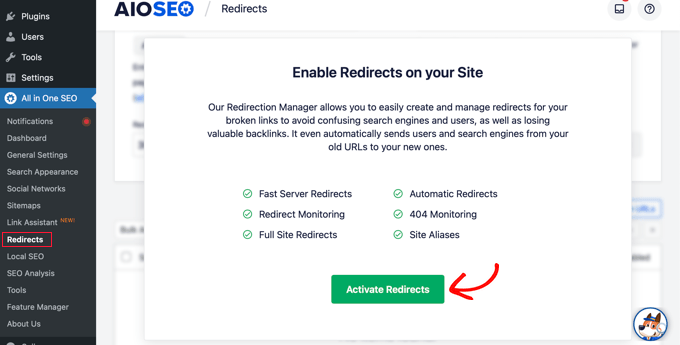
Następnie można kliknąć kartę “Ustawienia” i wybrać “PHP” jako metodę przekierowania.
Jest to najprostsza metoda tworzenia przekierowań i nie wymaga żadnej konfiguracji po stronie serwera.
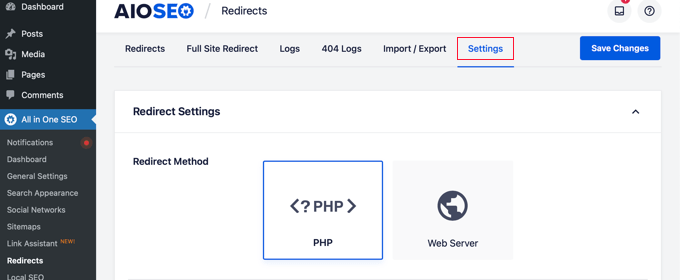
AIOSEO pozwala również wybrać metodę przekierowania serwera WWW. Wymaga to jednak skonfigurowania Apache lub NGINX na twoim serwerze WWW. Wymaga to wiedzy technicznej i nie jest zalecane dla początkujących.
Tworzenie przekierowań 301
Teraz możesz tworzyć przekierowania 301. Aby rozpocząć, przejdź do karty “Przekierowanie”.
Najpierw wpisz odnośnik, który chcesz przekierować w polu “Source URL”. Następnie należy wpisz nowe miejsce docelowe dla odnośnika w polu “Docelowy adres URL”.
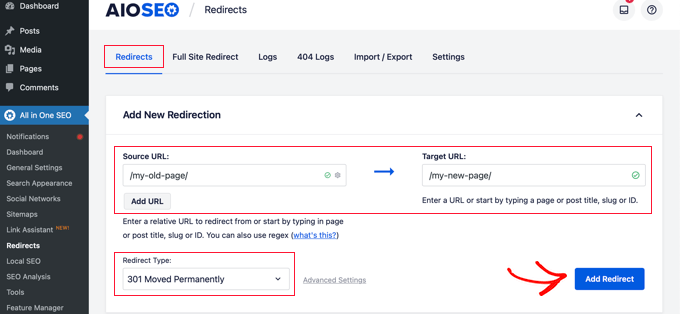
Teraz upewnij się, że rodzaj przekierowania to “301 Moved Trale”, a następnie kliknij przycisk “Dodaj przekierowanie”.
Jeśli chcesz przekierować wiele adresów URL do nowej lokalizacji, po prostu kliknij przycisk “Utwórz adres URL” pod polem Źródłowe adresy URL.
Następnie można przewinąć w dół, aby zobaczyć logi utworzonych przekierowań. Pokazuje on liczbę osób, które przeszły na przekierowany odnośnik w kolumnie “Trafienia” oraz opcję włączania lub wyłączania poszczególnych przekierowań 301.

Dodawanie przekierowań 301 w celu poprawki błędów 404
AIOSEO może również pomóc w śledzeniu stron błędów 404 i ich poprawkach.
Aby włączyć tę opcję, należy przewinąć w dół do sekcji “Dzienniki przekierowań” na karcie Ustawienia. Następnie włącz opcje “404 Logs” i “Redirect Logs”.
Można również wybrać okres przechowywania logów. Zalecamy przechowywanie ich przez maksymalnie jeden miesiąc, aby zapewnić płynne i szybkie działanie serwera.
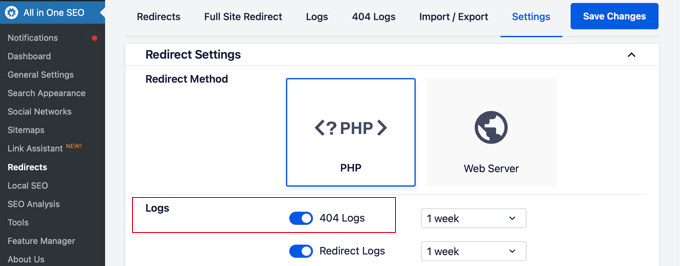
Po włączeniu tych opcji należy kliknąć przycisk “Zapisz zmiany”.
Teraz w sekcji Przekierowania powinna pojawić się nowa karta “404 Logs”. To tutaj AIOSEO będzie śledzić i pokazywać twoje niedziałające odnośniki i pozwoli ci ustawić przekierowania. Zobaczysz również liczbę przejść na odnośnik w sekcji “Trafienia” oraz datę i godzinę ostatniego dostępu.
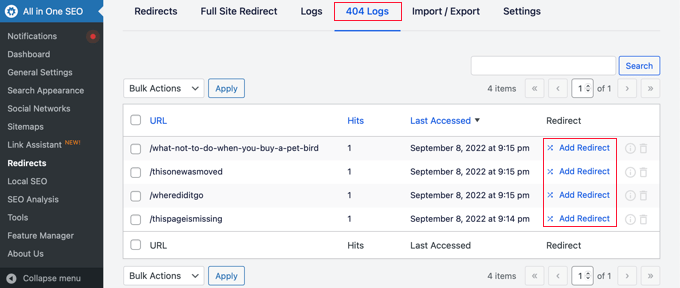
Uwaga: Po pierwszym włączeniu logów 404 nie znajdziesz żadnych danych. Wtyczka zaczyna rejestrować strony błędów 404 dopiero po włączeniu ustawienia.
Następnie kliknij odnośnik “Dodaj przekierowanie” obok adresu URL błędu 404, który chcesz przekierować. Nie jest to przycisk na dole.
Zobaczysz teraz opcje pozwalające wpisz docelowy adres URL i wybierz rodzaj przekierowania z rozwijanego menu.

Wpisz swój nowy adres URL i wybierz “301 Moved Permanently” jako rodzaj przekierowania. Teraz należy kliknąć przycisk “Dodaj przekierowanie”.
AIOSEO utworzy teraz przekierowanie 301 dla twojego uszkodzonego odnośnika. Aby sprawdzić, czy przekierowanie działa prawidłowo, wystarczy przejść na stary adres URL i sprawdzić, czy użytkownik został przeniesiony do nowego miejsca docelowego.
Dodawanie przekierowań 301 bezpośrednio z wpisu lub strony
AIOSEO pozwala również na przekierowanie opublikowanego wpisu lub strony podczas jego edycji.
Jeśli przewiniesz do dołu strony w edytorze WordPress, znajdziesz sekcję Ustawienia AIOSEO. Należy kliknąć kartę “Przekierowania”.
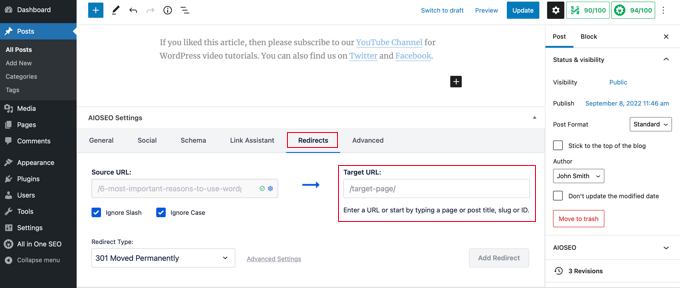
Źródłowy adres URL został już wypełniony. Po prostu wpisz nowy adres URL w polu “Docelowy adres URL” i wybierz “301 Moved Trale” z rozwijanego menu Rodzaj przekierowania.
Ponadto, jeśli zmienisz bezpośredni odnośnik wpisu podczas edycji, AIOSEO zaoferuje przekierowanie starego adresu URL na nowy.
Tak czy inaczej, kliknij przycisk “Dodaj przekierowanie” i gotowe.
Przekierowywanie pełnych witryn internetowych
Jeśli przeniesiesz swoją witrynę internetową na nową nazwę domeny, odwiedzający mogą napotkać niedziałające odnośniki, a SEO witryny może ucierpieć.
Możesz użyć AIOSEO, aby przenieść całą witrynę internetową do nowej lokalizacji bez utraty ruchu lub rankingów wyszukiwarek. Jest to pełne przekierowanie 301 witryny.
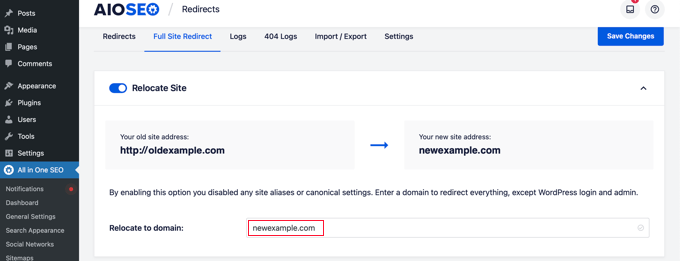
Ważne jest, aby zrobić to we właściwy sposób, dlatego stworzyliśmy przewodnik krok po kroku dla początkujących, jak wykonać pełne przekierowanie witryny za pomocą WordPress.
Metoda 2: Tworzenie przekierowań 301 za pomocą wtyczki Redirection
Innym sposobem dodawania i zarządzania przekierowaniami w WordPressie jest wtyczka Redirection.
Najpierw należy zainstalować i włączyć wtyczkę. Możesz skorzystać z naszego szczegółowego przewodnika na temat instalacji wtyczki WordPress.
Uwaga: Chociaż konfiguracja przekierowań 301 za pomocą wtyczki WordPress jest łatwa, ma ona pewne drobne wady wydajnościowe. W zależności od dostawcy hostingu WordPress, twoje przekierowania mogą być o kilka mikrosekund wolniejsze niż w przypadku innych metod.
Jeśli chcesz, aby twoje przekierowania były jak najszybsze, możesz to zrobić, edytując plik .htaccess przy użyciu poniższej metody 5.
Po włączaniu przejdź na stronę Narzędzia ” Przekierowanie, a następnie kliknij przycisk “Rozpocznij konfigurację”.
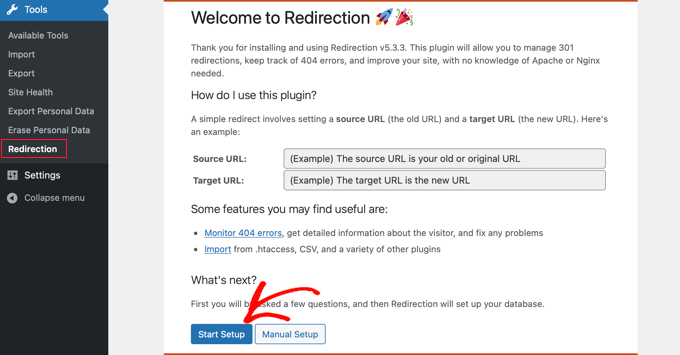
Następnie możesz wybrać opcje monitorowania zmian bezpośrednich odnośników w WordPressie i logować się do wszystkich twoich przekierowań i błędów 404.
Wystarczy włączyć te opcje i kliknąć przycisk “Kontynuuj konfigurację”.
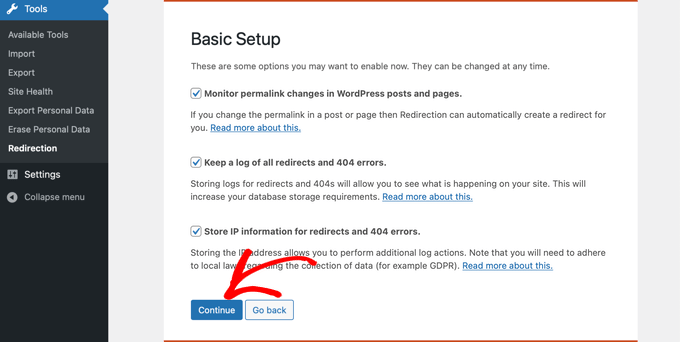
Wtyczka będzie teraz automatycznie testować Rest API.
Gdy status powróci jako Dobry, kliknij przycisk “Zakończ konfigurację”.
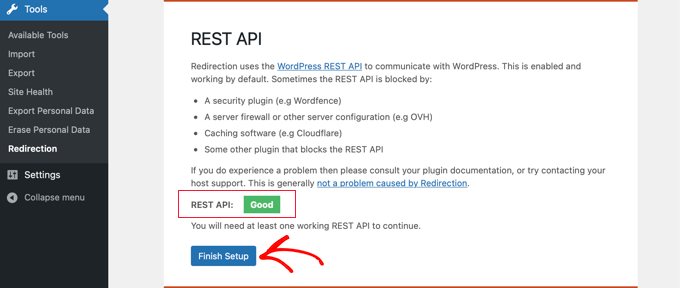
Wtyczka przekierowania wykona jeszcze kilka zadań, aby zakończyć konfigurację. Gdy pasek postępu osiągnie 100%, możesz kliknąć przycisk “Kontynuuj”, a następnie przycisk “Gotowe do rozpoczęcia”.
Wtyczka jest teraz gotowa do tworzenia twoich przekierowań 301. Aby rozpocząć, przejdź do sekcji Narzędzia ” Przekierowania w twoim panelu WordPress. Powinieneś spojrzeć na sekcję “Utwórz nowe przekierowanie” u dołu ekranu.
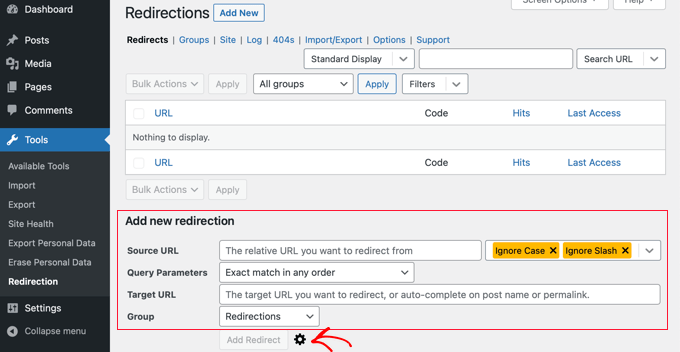
Zobaczysz podstawowe ustawienia, aby dodać przekierowanie. Jeśli jednak klikniesz ikonkę koła zębatego, zobaczysz więcej opcji wyboru twojego rodzaju przekierowania.
Po prostu wpisz źródłowy adres URL twojej starej strony i dodaj “Docelowy adres URL”, na który chcesz przekierować. Powinieneś także upewnić się, że opcja kodu HTTP jest ustawiona na “301 – przeniesione trwale”.

Gdy już wpiszesz wszystkie szczegóły, kliknij przycisk “Dodaj przekierowanie”.
Metoda 3: Tworzenie przekierowań 301 za pomocą wtyczki Simple 301 Redirects
Jednym z najprostszych sposobów tworzenia przekierowań 301 jest wtyczka Simple 301 Redirects. Jak sama nazwa wskazuje, sprawia ona, że przekierowania 301 są naprawdę proste.
Aby rozpocząć, należy zainstalować i włączyć wtyczkę na twojej witrynie internetowej.
Następnie należy przejść na stronę Ustawienia ” Przekierowania 301. Tutaj możesz wpisz stary adres URL w polu “Żądanie” i twój docelowy adres URL w polu “Miejsce docelowe”.

Gdy to zrobisz, kliknij przycisk “Utwórz nowy”, aby utworzyć przekierowanie 301. To wszystko.
Proste przekierowania 301 zaczną działać natychmiast.
Metoda 4: Przekierowanie istniejących stron z odnośnikami do wtyczki
Czasami możesz chcieć zachować wpis na kanale Twojej witryny lub stronę wymienioną w określony sposób w Twojej witrynie, ale mieć treść hostowaną gdzie indziej. W tym miejscu przydaje się wtyczka Page Links To.
Po zainstalowaniu i włączaniu wtyczki, dodaje ona pole meta do twojego edytora WordPress. Tutaj możesz wpisz adres nowej lokalizacji, do której chcesz wysłać swoich użytkowników.
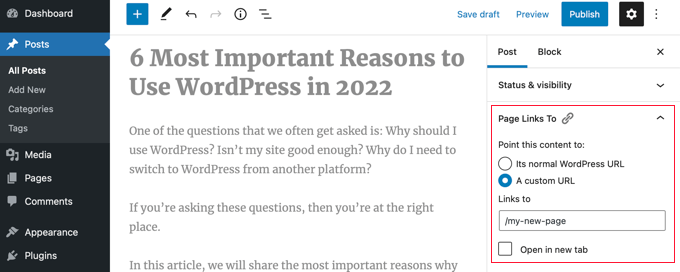
Po naciśnięciu przycisku “Aktualizuj” lub “Opublikuj” WordPress potraktuje wpis lub stronę w normalny sposób, ale gdy ktoś na nią przejdzie, zostanie przekierowany na wybrany konfigurator URL.
Na przykład, możesz mieć bloga, na którym od czasu do czasu tworzysz treści do pobrania, ale chcesz, aby użytkownicy twojej witryny sklepu internetowego widzieli niektóre wpisy jako produkty. Możesz użyć tej wtyczki, aby to zrobić, nie ryzykując kar za zduplikowaną treść od Google lub dzieląc twoją bazę użytkowników.
Metoda 5: Ręczne tworzenie przekierowań 301 przy użyciu .htaccess
Użytkownicy WordPressa mogą również ustawić przekierowania 301 poprzez edycję pliku konfiguracyjnego serwera WWW .htaccess.
Należy pamiętać, że niewielki błąd w kodzie .htaccess może sprawić, że twoja witryna WordPress będzie niedostępna i może zacząć wyświetlać wewnętrzny błąd serwera.
Dlatego ważne jest, aby przed wprowadzeniem jakichkolwiek zmian wykonać kopię zapasową twojego pliku .htaccess.
Edytuj swój plik .htaccess za pomocą wtyczki All in One SEO
Jeśli masz zainstalowaną wtyczkę All in One SEO, to oferuje ona łatwy sposób edycji twojego pliku .htaccess.
Uwaga: Do korzystania z edytora .htaccess wymagany jest program All in One SEO Pro.
Wystarczy przejść na stronę All in One SEO ” Tools i przełączyć się na kartę “.htaccess Editor”.
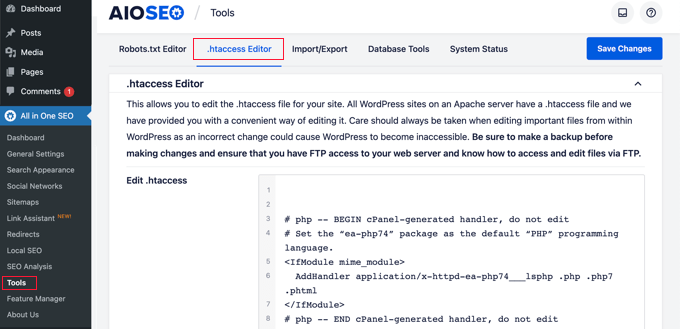
Z tego miejsca zobaczysz treść twojego pliku .htaccess w edytorze. Możesz po prostu umieścić dowolny kod przekierowania, który chcesz dodać na dole po linii “# END WordPress”.
Oto proste przekierowanie, w którym próbujemy wysłać użytkownika przechodzącego na stary wpis do nowego wpisu.
RewriteEngine OnRedirect 301 /a-very-old-post/ http://yoursite.com/a-very-new-post/ |
Nie zapomnij zmienić adresów URL starego i nowego wpisu. Po zakończeniu kliknij przycisk “Zapisz zmiany”, aby zapisać twoje ustawienia, a All in One SEO zaktualizuje twój plik .htaccess.
Bezpośrednia edycja twojego pliku WordPress .htaccess
Możesz również bezpośrednio edytować twój plik .htaccess WordPressa, aby skonfigurować dowolne przekierowania.
Aby edytować plik .htaccess, musisz połączyć się z twoją witryną internetową za pomocą klienta FTP. Plik .htaccess znajduje się w katalogu głównym twojej witryny WordPress.
Jeśli nie widzisz swojego pliku .htaccess, zapoznaj się z naszym przewodnikiem na temat tego, dlaczego nie możesz znaleźć pliku .htaccess na swojej witrynie WordPress.
Możesz pobrać .htaccess na twój komputer i edytować go za pomocą edytora tekstu, takiego jak Notatnik.
Możesz użyć poniższego kodu przekierowania, aby wysłać użytkownika, który przejdzie na stary wpis do nowego wpisu. Kod należy wkleić na końcu twojego pliku .htaccess po linii “# END WordPress”.
RewriteEngine OnRedirect 301 /a-very-old-post/ http://yoursite.com/a-very-new-post/ |
Upewnij się, że zmieniłeś adres URL starego i nowego wpisu. Następnie możesz zapisać twoje zmiany i przesłać plik .htaccess z powrotem na serwer.
Teraz możesz przetestować twoje przekierowanie, aby upewnić się, że przekierowuje prawidłowo, zgodnie z zamierzeniami.
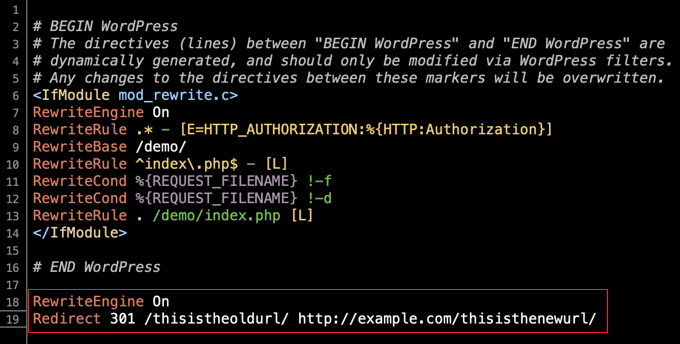
Ponadto możesz również uzyskać dostęp do pliku .htaccess i edytować go za pośrednictwem kokpitu dostawcy hostingu i wbudowanego menedżera plików.
Na przykład, możesz znaleźć .htaccess w menedżerze plików SiteGround, przechodząc do Narzędzia witryny “ Witryna “ Menedżer plików i nawigując do katalogu /public_html/ twojej witryny.
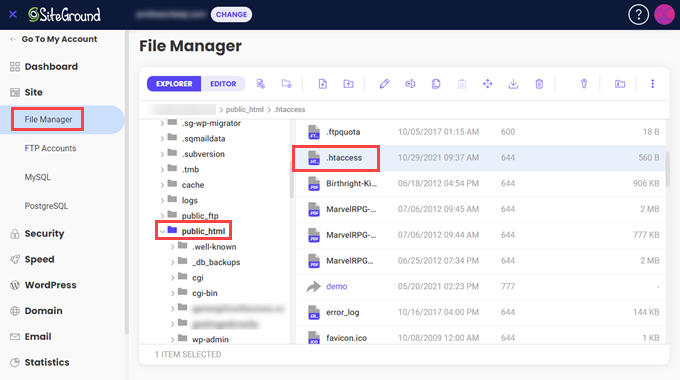
Następnie możesz kliknąć prawym przyciskiem myszy plik .htaccess i wybrać opcję “Edytuj”.
Wystarczy bezpośrednio dodać kod przekierowania 301 i zapisać plik. Ponownie, pamiętaj, aby pobrać oryginalny plik .htaccess w celu utworzenia kopii zapasowej.
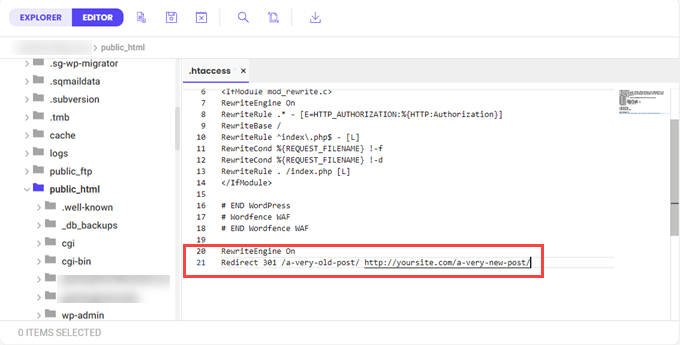
Mamy nadzieję, że ten przewodnik dla początkujących dotyczący tworzenia przekierowań WordPress pomógł ci skonfigurować przekierowania na twojej witrynie. Możesz również zapoznać się z naszym przewodnikiem na temat przekierowywania strony lub adresu URL w WordPress lub zobaczyć nasze wybory ekspertów dotyczące najlepszych wtyczek przekierowujących WordPress.
If you liked this article, then please subscribe to our YouTube Channel for WordPress video tutorials. You can also find us on Twitter and Facebook.





Laura
Hi
Is it possible to make a redirect from the wix platform to wordpress?
WPBeginner Support
Hi Laura,
Please see our guide on moving Wix to WordPress.
Admin
Hafiz Mateen Afzal
Which plugin is best to create referrel links like:
Thanks
WPBeginner Support
Hi Hafiz,
Thirsty Affiliates is the best way to manage your affiliate/referral links. Please see our guide on how to cloak affiliate links in WordPress.
Admin
cipriana leme
How do I redirect from a wordpress blog (free) to a .com blog? I cannot install plugins in the free blog, so how could I do the redirect? Any advice?
Thanks in advance
Hannah
Hello! I just created a website on WordPress.org and imported all of my content from my old site, example.wordpress.com (using WordPress.com). Is there a way to redirect all of the content from that site to my new one? The redirect instructions provided by WordPress gave me an error that the domain already exists, probably because it thought I was trying to create a new domain on WordPress.com.
My website traffic before is pretty minimal, so if anyone clicks on previous blog posts on my social channels, they’d be taken to the shut down version of my old site without the redirects – not the end of the world because I don’t have the following that would generate clicks at a later date, but you never know?
Any advice anyone has would be great!
Thanks,
Hannah
Senith Nal
your lesson is very helpful. i like it.
Shakoat Hossain
Brilliant solution to reduce redirects for worpress!
For a few days, I’m looking to solve my WP redirects issues. I don’t find out better solution even read this content.
Here, I got few good points and try to reduce redirect to increase my page load speed.
Thanks!
Roshni Kanchan
Hello,
Please can you tell me – in the simple 301 redirect in the request URL column does wordpress / plugin take it as starting from http or https? Form where does it pick up this value?
Thanks for the article. It was useful. However the redirects using 301 redirect plugin is not working and landing on ‘Page does not exist’ page.
WPBeginner Support
Hi Roshni,
It uses your WordPress Site Address as defined in WordPress Settings > General page.
Admin
Nalin
Hi,
If I want to change the url structure of my posts, even then redirection is necessary? Isn’t that already taken care of in WP?
Also if I don’t redirect, will it be harmful for seo or search engines can figure out WP’s automatic redirection?
Melissa
Very helpful. Thank you for the tip. Thank you for making it so simple.
Melissa
Walter A.
Thanks so much, I would’ve spent so much time doing it the long way. So happy Redirection worked instantly after install.
Cristian Adam
Hi Wpbeginner, I have a question about 301 permanent redirect and your advice will be great. I have an website about snoring and on that website are 2 related articles, 1 of them ranks for a lot of kws position 2-10 ( article A) and the other one just for 4-5 kws position 1-3 (article B). Both articles are on first google page and I want to permanent redirect the article B to A. Also on my website are some articles that point to article B and I want them to point to article A using same anchor texts. Now my question: Does this changes will pass the juice to article B to A and it will increase the article A rankings? And if I do this changes should I delete article B and reuse the content on other websites? Thank you very much for your time I will wait your answer, please excuse my bad english.
WPBeginner Support
Hi Christian,
A 301 redirect will pass the link juice to new article. However, other search ranking factors would also apply to the new article, like relevance, context, keyword density, and more. Search engines may not find it relevant for the old keywords.
Admin
Raj
Hi WP beginner team,
A quick question.
Last year, when we changed URLs, WordPress was automatically redirecting Old urls to new urls.
But after a recent wordpress core update, the automatic redirection is not happening.
Would you be able to explain? Or am I missing anything
Adebowale Adewale
I am changing the domain of a wordpress website example.com to example.com.ng . I tried several 301 redirect rules in .htaccess , only the homepage redirects.
Please, assist me on the right code.
I have tried each seperately :
# BEGIN WordPressRewriteEngine OnRewriteCond %{HTTP_HOST} ^www.example.comRewriteRule (.*) http://www.example.com.ng/$1 [R=301,L]# END WordPressand
RewriteEngine onRewriteCond %{HTTP_HOST} ^example.com [NC,OR]RewriteCond %{HTTP_HOST} ^www.example.com [NC]RewriteRule ^(.*)$ http://example.com.ng/$1 [L,R=301,NC]None is working for me.
Adebowale Adewale
Thank you so much! I am very grateful.
Shubham Davey
Do I need to own the domain while redirecting? My Domain is getting expired on 31st July and I will be redirecting to a new domain. So while it is redirected do I need to own the domain after 31st?
WPBeginner Support
Hey Shubham,
Yes, you will need that domain for your redirects to continue working.
Admin
christian
I have over 850 old post which I recently deleted on my site due to some reasons. I want to ask if there is an easy and automated way to redirect all the old post to just one post. The methods you listed are easy to do if you are trying to redirect 1 or 2 posts. pls, help me. Your reply is important.
christian
Is my question not also important? pls, your reply will be very appreciated. I need this.
Haitham Alnaqeb
You can try the permanent redirection methods from the cPanel. You can redirect all your 404 error into particular page.
Harmony A-E
Can I redirect my wp-login to a 401 (unauthorized) page using this plugin?
Ahu
Hi, this is a very helpful post thank you, but it seems like the instructions are for redirects from WP to WP.
I am moving my website from WordPress to New Kajabi platform.
I have around 250 post/pages in WP to 301 redirect to my new kajabi site.
My domain name will be the same but the url structures and names of the posts/pages will be different.
Would the tools you recommend still work in my case? If yes, how?
I would appreciate your urgent reply, Thank you
Ahu
Zoltan
One thing I’m not clear about. Actually 2 things. 1 – Do I do the redirect on my new site or my old site. 2 – Where do I get a full list of my web pages from the old site?
Lokesh thota
Hi. I have a WordPress website with 100 posts. But most of the backlinks are to the post rather than to the homepage. Does any of the methods above redirect all the posts to the new URL also. I want a 301 redirect to my new domain from only one URL.not all the 90 URLs.but at the same time I don’t want to lose link juice from those posts. Please specify a way to first redirect all the old posts to old homepage then redirect the old homepage to new URL.
Ado
Hi, thanks for this info, very helpful.
So I decided to use the Simple 301 Redirects plugin… but did something REALLY dumb….
My wordpress site is still located in a subdirectory, with the Site address set to the main url (so WordPress Address URL is http://example.com/dev2017 and Site Address URL is http://example.com and .htaccess file updated)
There were some google search results showing the subdirectory address, so I installed the plugin and set a redirect with a wildcard for the subdirectory (obviously wasn’t thinking very well) and so now I can’t get in to the WP admin (as it’s in the subdirectory!!)
Is there a way to undo the redirects somehow? If I uninstall the plugin via FTP is it going to break the website???
Silly me….
WPBeginner Support
Hey Ado,
First you need to deactivate plugin. After that you need to delete the .htaccess file in your site’s root folder. You will be able to login to your WordPress site. Once logged in you will need to regenerate .htaccess file. Simply visit Settings » Permalinks and then click on the save changes button without changing anything.
Admin
Fumio Mori
can i use request url with variable?
Jennifer
Could not have been easier! Thank you
Philemon O'Arpelleh
Please, I changed the permalink of my WordPress site from
http://www.example.com/blog/%postname%tohttp://www.example.com/articles/%category%/%postname%and ALL my previous posts are affected.Please help me on how to setup a onetime redirection for ALL posts.
Thank you.
WPBeginner Support
Hey Philemon,
You can do that by visiting the permalinks page under settings.
Admin
Mark
What is the best way to redirct adress like that: mywbsite.com/wp-content/uploads/2008/12/mybook.pdf to normal web page. Tha it not normal wordpress page or post but is ranking on some keywoords and i would like to redirect to specyfic wordpres page. WHAT metod redirection should i use ? In that case simple 301 edirect plugin not work for me.
thanks
Chrissy
I have what may be a silly question. I have a site that is not a WordPress site (it’s using Shopify right now) and I am recreating the site on a new URL in WordPress. Will the redirect plugins still work to direct the old (Shopify) links to the New (WordPress) ones?
WPBeginner Support
Hey Chrissy,
WordPress plugins will be installed on your WordPress site. They can redirect users to correct post/page/product once the user reaches your website. You will have to redirect Shopify visitors to your WordPress site, and then redirect plugins take it from there.
Admin
Thom Duncan
I’m able to create a redirect using the Redirection plug-in, but with this problem:
/old/ to /new/ works fine, but
/old to /new/ picks up pages that I do not want to redirect, such as
/old-2016 which then points to the non-existent /new/-2016.
Charles D. Shell
I have an annoying problem. My site had the default settings for the blog posts, so I set up redirects and changed it to the %postname% option. Unfortunately, when I do that, my home (blog) page disappears. I’ve been chasing this problem for a while. Do you have a video with a solution? Or at least a way to point me in the right direction?
Ana
I don’t know if I understand your problem but my suggestion is not to redirect the url (using plugins or at the .htacess). You need to change de permalinks structure at the WP configuration. Somthing like this: https://www.wpbeginner.com/plugins/how-to-change-custom-post-type-permalinks-in-wordpress/
I hope I could help.
Sorry about my english
Charles D. Shell
When I change the permalink structure on the dashboard to %postname%, my home page http://charlesdshell.com/blog/ disappears. Or rather all blog posts and widgets disappear. All that’s left is a 404 error message.
All the redirects on all the pages work fine, but I can’t seem to get the home page to stick around.
Yeshna
I want to redirect my site form wordpress.com to wordpress.org. Is there any other way to redirect for free?
By the way,are those plugins free?
WPBeginner Support
Hi Yeshna,
Unfortunately, you will have purchase the redirect service from WordPress.com to redirect your old WordPress.com blog traffic to your new WordPress.org blog.
Admin
Steve
I want to redirect my current live wordpress site (hosted by Hostgator) to a new domain name that I just bought from Godaddy. My questions are: 1) does my new domain name need to be hosted by HG in order to have my live site redirect to the new domain name. 2) does the new domain site need to have content already?
Thank you for your help.
Aleen
Is there a way to do bulk redirects with one of these plugins? I want to update my permalinks to exclude the date, but don’t want to have to manually redirect 200+ posts. Please help!
Also, thanks for all of your great articles. You are great at putting them in non-technical terms.
nelson
i want to know if this could be done. have a user that had a site working, after i installed wordpress they wanted to change to wordpress so i created them a space and a site that calls wordpress/newsite.
now i want:
when typing my.old.url/site the information that comes out should be worpress/newsite
could this be possible whith the redirect.
Aslam Khan
I have deleted some of my posts from my website earlier.
Now, I am getting not found errors for those pages as expected.
I tried to redirect old URLs using a method provided by my hosting provider. But those redirects are not working.
I want to ask, if I use .htaccess redirects and keep previous redirects setup on hosting provider, can it cause any problems?
I need expert advice.
Laura
Ok, I am not sure why the .htaccess method is not working for me. I would like to avoid installing any more plugins on the client’s site. They have too many already for my liking. I’ve used your instructions because what I’ve used for redirect in the past didn’t seem to be working on her site for some reason. But this isn’t either. Not sure what the problem is. Have you run into this before? I’ve flushed the Permalinks, but am still getting a 404 when I try to go to the old URL I’ve rewritten.
Martin
I am having the ame problem here. It’s still not redirecting.
Rhys Clay
@Aslam & @Laura,
One little got ya with 301’s and wordpress via the .htaccess file is that you need to place your redirects between:
RewriteEngine On
And:
RewriteBase /
This is because wordpress has its own mods to the htaccess file to apply and changes the RewriteBase setting which I think causes problems with regular ol 301 redirects on shared hosting.
Mauro
Now how wpbeginner chooses to do redirection on the site? .htaccess, Redirections plugins, or what?
Thanks,
Jagdeep Singh
I installed this plugin it’s coming under “Setting” tab rather than “Tool” option.
Mike
Thank you very much for the tip on 301 Redirects plugin, works like a charm!
Sumit
I think in wordpress, there is no need to set redirection when changing slug of the post. It is done automatically. Right ?
Laura
If someone has bookmarked the old URL, for instance, or if the search engines have indexed the old URL and are still serving it in search results, you need to have a redirect in place so you aren’t losing traffic.
Allahlea
I research everywhere and I want to confirm what I learned.
I want to redirect my site form wordpress.com to wordpress.org. There is no other way to redirect but to pay for site redirect. Right? Is there any other option?
If there is no other way, can I redirect every single post for free? if there is HOW?
Kelly
ALLAHLEA, did you find an answer to this question? I want to know the same thing.
SK
Thank you very much. You saved my day. I need this post to redirect all my old posts to new posts. I have a question though. I just forwarded the old post to the new updated post, but I didn’t delete the old post contents. My old and new post have the same contents, but I redirected the old post to new post. Should I delete the contents of the old article to avoid plagiarism issues? Does it affect my SEO? Thanks again for this valuable post.
WPBeginner Support
No it is alright. Search engines understand that site-owners may want to redirect URLs for other reasons too.
Admin
Aditya Mankad
How I can have a redirect on a free wordpress account. I am pretty sure I cannot add a plug-in.
Is it possible or if not; another way to redirect the users to my new page (which is NOT a free hosting)
P.S gave the info about the new site as not free hosting because maybe something can be done about it.
WPBeginner Support
Please see our guide on how to properly move from WordPress.com to self hosted WordPress.org site.
Admin
Danny Flood
Thanks for this, but nothing is working for me. I have tried 3 different plugins – Quick Page / Post Redirect, Simple 301 Redirects, and Redirection. The only thing they are able to accomplish is redirect me when I am logged in to WP-Admin. For non-logged in users, the redirect does not work. How do I fix this?
Jim
I changed a TAG name.
How can I use your .htaccess solution to redirect old-tag to new-tag?
Is that possible?
Thx!
Anand
Oops…my comment, which was actually a question, doesn’t seem to have struck well with you.
It’s alright if you don’t have an answer. It just means, you need to work more & better.
Thanks anyway
WPBeginner Support
We answered your comment. sorry for the delay.
sorry for the delay.
Admin
Anand
Hi,
Thanks for introducing the redirection plugins.
Using the ‘redirection’ pluginsis it possible to add bulk redirects?
The case in point is change in domain name, where you would want to redirect all pages from old domain to new domain. Adding redirects one by one for each page doesn’t sound like a good solution.
Appreciate you help please.
WPBeginner Support
Yes, it is possible.
Admin
Johnny
WOW! Thank you!
Denika
When using the coding way to get a redirect, do you need to include RewriteEngine On for each redirect? Or do you include it once and just follow through with each redirect on it’s own line?
nina
So, do we keep google search positions with redirects, lets say my posts i want to redirect are on the first page of google What happens after redirect? Thanks, hoping for an answer.
WPBeginner Support
If you are doing a 301 redirect, then Google will consider replacing your new url with the old one. However, the position of that page in search results will depend on whatever content it has. For example, if your old page was about “apples” and your new page is about “oranges” then it will certainly not appear for apples related keywords anymore.
Admin
Nina
Thanks, i have one more question. I forgot to tell you i want to redirect some posts from blog A, to new blog B. I can still use these techniques? I have to copy paste old content to new post on blog B then am i right ? I want content to stay the same, only want it to be shown on blog B instead of blog A. In this case google also keeps rankings or not?
Thanks a lot again:)!
Raghu koorthy
Can you pls run a article on how to create a landing page or squeeze page and link it to mail chimp. Thank you.
Raghu Koorthy
Simple but very useful information.
I started working with WP recently and YOUR BLOG is the first point of reference when I need help.
Thank you team for your help.
Esmaeil
Short and useful. Thanks a lot.